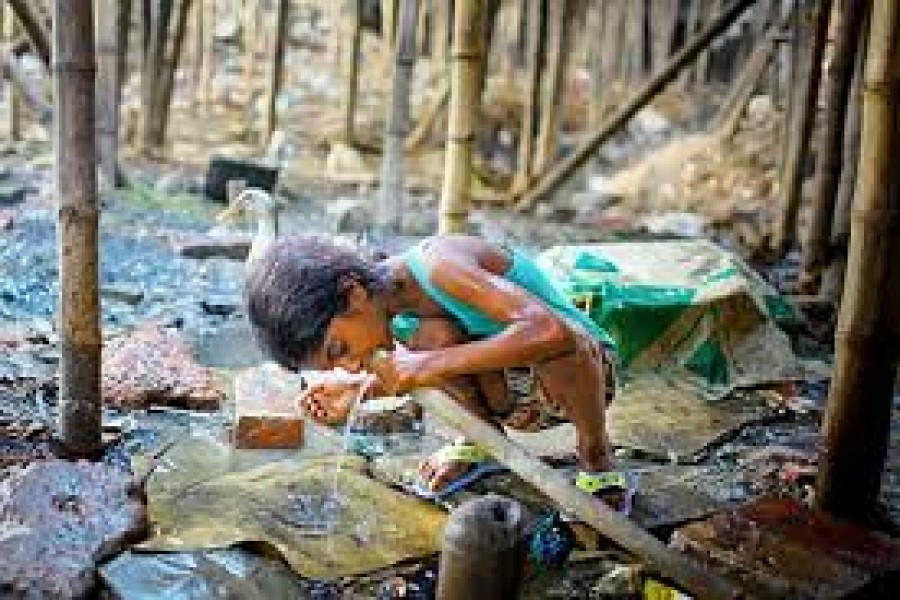
Published :
Updated :

The concentration of 99 per cent of world's wealth in one per cent of its inhabitants has made screaming headlines -- and genuinely so. That the 99 per cent of the world population has to do with just one per cent of its wealth, however, has an encouraging message. The world can provide for a far larger size of population with the wealth at its disposal right now. But wealth the world over is increasing.
Against wealth creation at a decent pace, it is also true that the people's living standard in the majority of countries is improving. Only in a few conflict-ridden countries living standard is on the decline. That the governments all across the globe are yet to introduce an economic order where shared prosperity for all their citizens is just or equitable has indeed left open many avenues for the privileged and influential to eat the cream. Social discrimination has remained unbridgeable and in many cases it is yawning. It is because of this, governments and the United Nations have to formulate targeted policies in order to reduce poverty.
How do the majority of the world population fare then? The answer cannot be straight and simple. But it is assumed that at least half of them are financially and on measures of several other indicators of life are fine. Actually, the World Bank has drawn a line on the one side of which 60 per cent of people lead a more or less decent life. The multilateral financial organisation has focused on the rest 40 per cent to know if the planet's inhabitants are becoming more capable in changing their lot.
The tiding, if the WB's analysis of economic dynamics over the past 25 years is to be believed, is quite encouraging. In its Piecing Together the Poverty Puzzle -- the 2018 edition, the WB has shown that the percentage of poverty has globally dropped to the lowest ever in 2015 -- the latest available figures. Most likely it has declined still further -- if not to a single digit; at least by a few percentage points. However, if the rate of fall remains steady at one percentage point a year -- which prevailed over the 25 years from 1990 to 2015, the world poverty may indeed have dipped to a single digit by now. During the period global extreme poverty fell from 36 per cent to 10 per cent. But slowing down of the progress in poverty reduction in the last couple of years from 2013-15 surely does not bode well.
However, here the count is on the basis of the line of poverty drawn at $ 1.90. Anyone living on less than this amount a day is considered extreme poor. Clearly, the lowest possible amount is not enough for a decent living. It may just help one's mere survival. So, the WB has to redefine poverty. This is because varying living costs in countries are responsible for making poverty felt at different degrees. The same amount of money spent in Bangladesh and Australia cannot buy equal volume of foods and other goods. So, two more poverty lines have been drawn at $3.20 and $5.50 for a day's living. These are typically designed as standards for the lower- and upper-middle-income countries. It is interesting to know that a quarter of the planet's citizens live on $3.20 and almost half of the total live on less than $5.50 a day.
Now the picture becomes clearer on the state of economy that governs the bottom half of the world population. There is no doubt that uneven distribution of wealth has been responsible for deprivation of the majority of the population both in a national boundary and all across the globe. Access or no access to education, utilities and basic infrastructure determines the fate of people. On the basis of this a new poverty line has been drawn. Each country's typical level of income and consumption has been taken into account to place the bottom 40 per cent relative to their societies. This means that people's poverty level is determined by their respective status compared to the average societal standard. No wonder it has been named societal poverty line.
This is definitely a shift from the previous definition of money-only poverty. If people have no access to utilities like electricity, potable water, health facilities, sanitation and an array of community services, life cannot attain an acceptable level by any means. This means that the houses or huts they live in act as the primary discriminatory factor. But as members of society everyone --poor or rich -- should be brought under some community and utility services. There is no point that the city people will only enjoy the best of such offerings. Public roads, supply water, natural gas, drainage facilities cannot be the prerogatives of the city people alone.
Above all, it is the access or not to education that puts the great divide between people. Quality education is a rare commodity in Bangladesh now. But money can buy it for some. Still others not equally well off also purchase education that earns certificate and employment either at home or abroad. The bottom line is a sharper division in society. In order to do away with social and economic discrimination, therefore, there is no alternative to making quality education available to all. But it has to be free of cost for the disadvantaged class.


 For all latest news, follow The Financial Express Google News channel.
For all latest news, follow The Financial Express Google News channel.